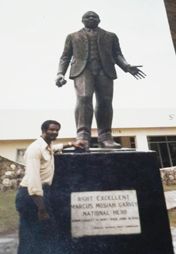Marcus Garvey and St Vincent

Imagine the first two decades of the 20th century, the United States of America overripe with racism and black leaders like Asa Philip Randolph, Chandler Owen and W.E.B. Dubois struggling to organise black people.{{more}}
W.E B. Duboisâ National Association for the Advancement of Coloured People was formed in 1909. Conflicts arose among black leaders over strategy, philosophy and struggle for influence. Into this milieu appears a Jamaican, Marcus Garvey, who was able, in a short period of time, to organise a mass political movement that had a following not only in the US, but just about everywhere that black people lived. The United States and the British in particular, who had their wings spread all over the world, considered him a serious threat.
J. Edgar Hoover of the US Department of Justice, in a communiqué of October 11, 1919, made this clear: âGarvey is a West Indian Negro and in addition to his activities in endeavouring to establish the Black Star Line Steamship Corporation he has also been particularly active among the radical elements in N.Y City in agitating the Negro movement. Unfortunately, however, he has not yet violated any federal law whereby he could be proceeded against on the grounds of being an undesirable alien, from the point of view of deportation. It occurs to me, however, from the attached clipping that there might be some proceeding against him for fraud in connection with his Black Star Line…â
It was not only the United States Government that was out to get him, for other black leaders were also conspiring against him. In fact, historian Manning Marable attributed the collapse later on of Garveyâs organisation, the Universal Negro Improvement Association, to the work of Asa Philip Randolph. He states: âThe irony of this entire episode was that Randolph, a would-be leader of the black working class, had participated in the destruction of the largest black worker and peasantsâ organisation in U.S history.â
But, outside the US, Garveyâs enemies were at work. There were six branches of his organisation in St Vincent, totalling a membership of 475, with Stubbs being the largest. The Negro World, an organ of the organisation, was banned in St Vincent in October 1919. R.E.M Jack, one of the organisers, was constantly harassed. Garvey had to write the Administrator in 1920, denying information damaging to the UNIA that was supplied by one Samuel Duncan, who was a resident of New York City. Efforts were made to deny him a visa on one of his trips abroad. Tony Martin, in his âMarcus Garvey, Hero – A First Biography,â noted that Garvey was constantly harassed, âThe authorities liked to arrest him every year in the middle of his international conventions. The charges usually came to nothing…â
Garvey was eventually charged in connection with the Black Steamship Corporation. According to Martin he was charged with misleading shareholders into expecting a profit when he knew there would not be any and for sending fraudulent circulars through the mail. â…the government could do no better than produce an empty envelope bearing a Black Star Line stamp and addressed to a former shareholder. The court simply presumed that the envelope was authentic and that certain circulars had been in it.â
The Hugh Mulzac Connection
It appeared that sabotage had been involved by some officers and workers, but ultimately it was lack of proper management that allowed things to get out of hand. Hugh Mulzac had a lot to say about this in his autobiography. He was put in touch with Mulzac by a Vincentian friend, Billy Rose. Garvey welcomed him and placed him on his first ship the âYarmouthâ that sailed on February 27, 1920 to Cuba. Mulzac described the enthusiastic reception they had everywhere the ship went. In Cuba âsympathisers flocked from all parts of the island toward the docks to greet the first ship they had ever seen entirely owned and operated by coloured men. They came out in boats when we arrived, showering us with flowers and fruit.â
At a banquet at the Presidential Palace, the President â…expressed his great pride in seeing coloured men make their own opportunities in the field of commerce. Before the evening was over he promised the support of the Cuban government for the ventures of the Black Star Line…In scores of formal and informal gatherings the officers and men of the Yarmouth were feted and at everyone some Cuban businessmen promised us his trade…â
Perhaps one of the biggest receptions was at Bocas Del Toro in Panama. âAt Bocas Del Toro thousands of peasants came down from the hills on horses, donkeys and in make shift carts and by a special train provided by the United Fruit Company, which, since it was going to lose its employees for the day anyway, declared a legal holiday. The crowd on the dock was so thick that when we threw our heaving lines ashore the peasants seized the hawsers as they came out of the water and literally breasted us alongside the dock…â
He said about their reception elsewhere in Panama: âLiterally thousands of Panamanians swarmed the docks with baskets of fruit, vegetables and gifts. I was amazed that the Yarmouth had become such a symbol for coloured people of every land…â
What should have been the âflagshipâ to catapult the corporation and organisation on the way to the Promised Land instead signalled the collapse not only of the Black Star Line, but of Garvey and his Universal Negro Improvement Association.
(Next week we will look at what Mulzac had to say about this).









